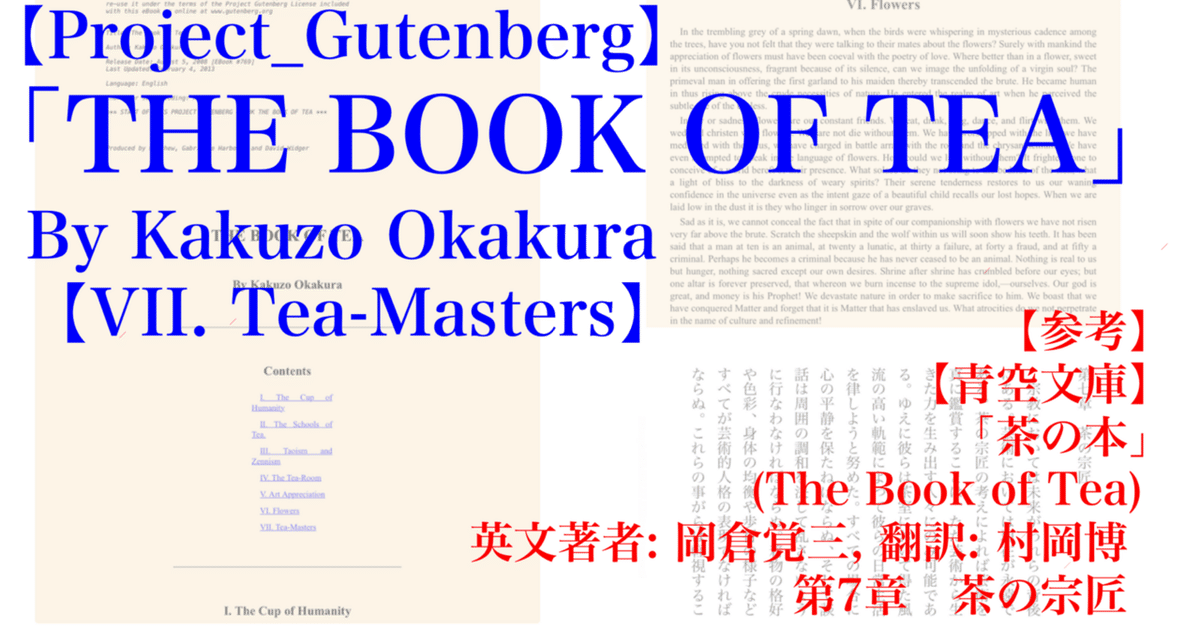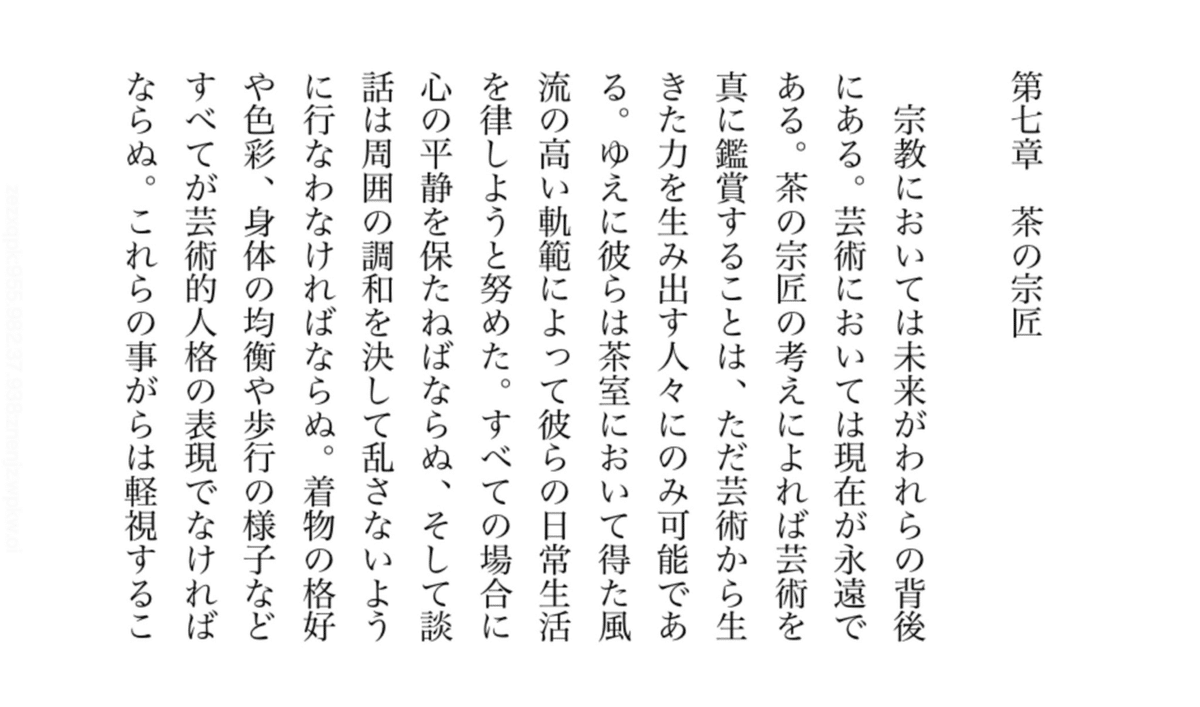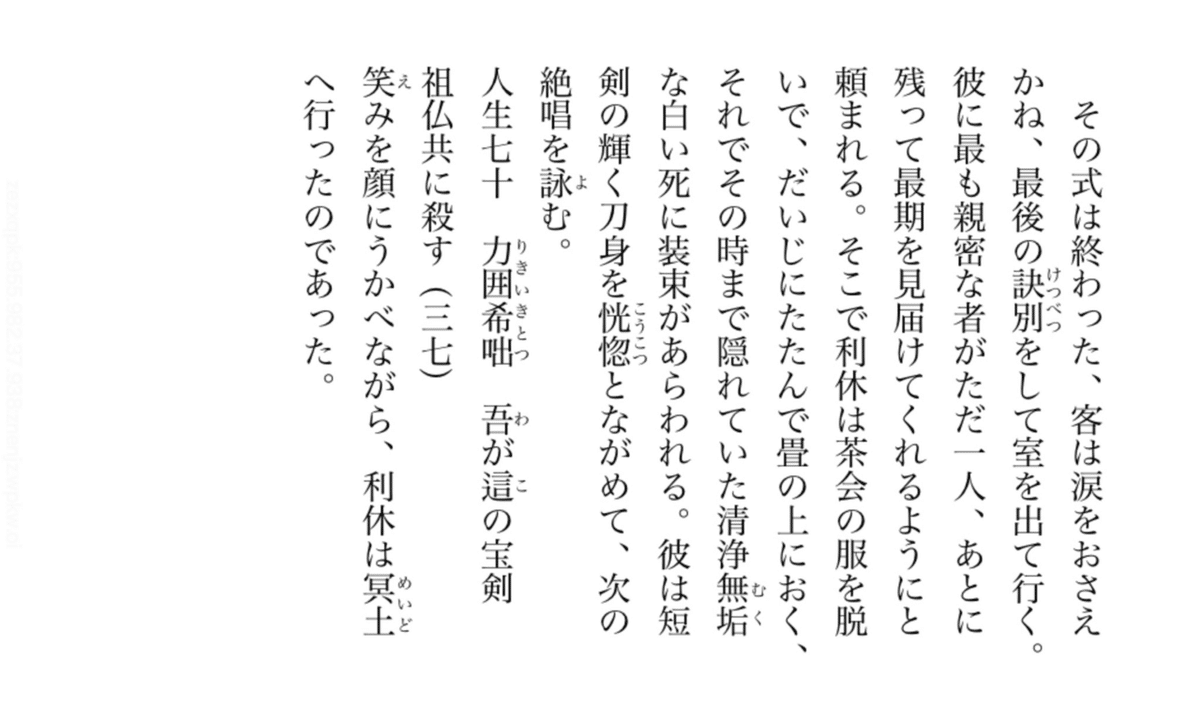
【Project_Gutenberg_200im】「THE BOOK OF TEA」その7【VII. Tea-Masters】
〜〜【Project_Gutenberg】→Web翻訳版→【Project_Gutenberg_200im】
〜
THE BOOK OF TEA
By Kakuzo Okakura
〜
【Contents】
I. The Cup of Humanity
II. The Schools of Tea
III. Taoism and Zennism
IV. The Tea-Room
V. Art Appreciation
VI. Flowers
VII. Tea-Masters ←今回の紹介
〜
〜〜
〜〜[上記【Project_Gutenberg】の翻訳は以下の通り。翻訳にはアプリ「DeepL」を使用。]
〜
茶の本
岡倉覚三著
〜
内容
I.人類の杯
II.お茶の学校
III.道教と禅教
IV.茶室
V.芸術鑑賞
VI.花
VII.茶人 ←今回の紹介
〜
〜〜
【出所】URL> https://www.gutenberg.org/files/769/769-h/769-h.htm
〜〜【Project_Gutenberg】THE BOOK OF TEA
〜
VII. Tea-Masters
In religion the Future is behind us. In art the present is the eternal. The tea-masters held that real appreciation of art is only possible to those who make of it a living influence. Thus they sought to regulate their daily life by the high standard of refinement which obtained in the tea-room. In all circumstances serenity of mind should be maintained, and conversation should be conducted as never to mar the harmony of the surroundings. The cut and color of the dress, the poise of the body, and the manner of walking could all be made expressions of artistic personality. These were matters not to be lightly ignored, for until one has made himself beautiful he has no right to approach beauty. Thus the tea-master strove to be something more than the artist,—art itself. It was the Zen of aestheticism. Perfection is everywhere if we only choose to recognise it. Rikiu loved to quote an old poem which says: "To those who long only for flowers, fain would I show the full-blown spring which abides in the toiling buds of snow-covered hills."
Manifold indeed have been the contributions of the tea-masters to art. They completely revolutionised the classical architecture and interior decorations, and established the new style which we have described in the chapter of the tea-room, a style to whose influence even the palaces and monasteries built after the sixteenth century have all been subject. The many-sided Kobori-Enshiu has left notable examples of his genius in the Imperial villa of Katsura, the castles of Nagoya and Nijo, and the monastery of Kohoan. All the celebrated gardens of Japan were laid out by the tea-masters. Our pottery would probably never have attained its high quality of excellence if the tea-masters had not lent it to their inspiration, the manufacture of the utensils used in the tea-ceremony calling forth the utmost expenditure of ingenuity on the parts of our ceramists. The Seven Kilns of Enshiu are well known to all students of Japanese pottery. Many of our textile fabrics bear the names of tea-masters who conceived their color or design. It is impossible, indeed, to find any department of art in which the tea-masters have not left marks of their genius. In painting and lacquer it seems almost superfluous to mention the immense services they have rendered. One of the greatest schools of painting owes its origin to the tea-master Honnami-Koyetsu, famed also as a lacquer artist and potter. Beside his works, the splendid creation of his grandson, Koho, and of his grand-nephews, Korin and Kenzan, almost fall into the shade. The whole Korin school, as it is generally designated, is an expression of Teaism. In the broad lines of this school we seem to find the vitality of nature herself.
Great as has been the influence of the tea-masters in the field of art, it is as nothing compared to that which they have exerted on the conduct of life. Not only in the usages of polite society, but also in the arrangement of all our domestic details, do we feel the presence of the tea-masters. Many of our delicate dishes, as well as our way of serving food, are their inventions. They have taught us to dress only in garments of sober colors. They have instructed us in the proper spirit in which to approach flowers. They have given emphasis to our natural love of simplicity, and shown us the beauty of humility. In fact, through their teachings tea has entered the life of the people.
Those of us who know not the secret of properly regulating our own existence on this tumultuous sea of foolish troubles which we call life are constantly in a state of misery while vainly trying to appear happy and contented. We stagger in the attempt to keep our moral equilibrium, and see forerunners of the tempest in every cloud that floats on the horizon. Yet there is joy and beauty in the roll of billows as they sweep outward toward eternity. Why not enter into their spirit, or, like Liehtse, ride upon the hurricane itself?
He only who has lived with the beautiful can die beautifully. The last moments of the great tea-masters were as full of exquisite refinement as had been their lives. Seeking always to be in harmony with the great rhythm of the universe, they were ever prepared to enter the unknown. The "Last Tea of Rikiu" will stand forth forever as the acme of tragic grandeur.
*****
Long had been the friendship between Rikiu and the Taiko-Hideyoshi, and high the estimation in which the great warrior held the tea-master. But the friendship of a despot is ever a dangerous honour. It was an age rife with treachery, and men trusted not even their nearest kin. Rikiu was no servile courtier, and had often dared to differ in argument with his fierce patron. Taking advantage of the coldness which had for some time existed between the Taiko and Rikiu, the enemies of the latter accused him of being implicated in a conspiracy to poison the despot. It was whispered to Hideyoshi that the fatal potion was to be administered to him with a cup of the green beverage prepared by the tea-master. With Hideyoshi suspicion was sufficient ground for instant execution, and there was no appeal from the will of the angry ruler. One privilege alone was granted to the condemned—the honor of dying by his own hand.
On the day destined for his self-immolation, Rikiu invited his chief disciples to a last tea-ceremony. Mournfully at the appointed time the guests met at the portico. As they look into the garden path the trees seem to shudder, and in the rustling of their leaves are heard the whispers of homeless ghosts. Like solemn sentinels before the gates of Hades stand the grey stone lanterns. A wave of rare incense is wafted from the tea-room; it is the summons which bids the guests to enter. One by one they advance and take their places. In the tokonoma hangs a kakemon,—a wonderful writing by an ancient monk dealing with the evanescence of all earthly things. The singing kettle, as it boils over the brazier, sounds like some cicada pouring forth his woes to departing summer. Soon the host enters the room. Each in turn is served with tea, and each in turn silently drains his cup, the host last of all. According to established etiquette, the chief guest now asks permission to examine the tea-equipage. Rikiu places the various articles before them, with the kakemono. After all have expressed admiration of their beauty, Rikiu presents one of them to each of the assembled company as a souvenir. The bowl alone he keeps. "Never again shall this cup, polluted by the lips of misfortune, be used by man." He speaks, and breaks the vessel into fragments.
The ceremony is over; the guests with difficulty restraining their tears, take their last farewell and leave the room. One only, the nearest and dearest, is requested to remain and witness the end. Rikiu then removes his tea-gown and carefully folds it upon the mat, thereby disclosing the immaculate white death robe which it had hitherto concealed. Tenderly he gazes on the shining blade of the fatal dagger, and in exquisite verse thus addresses it:
"Welcome to thee,
O sword of eternity!
Through Buddha
And through
Dharuma alike
Thou hast cleft thy way."
With a smile upon his face Rikiu passed forth into the unknown.
End of the Project Gutenberg EBook of The Book of Tea, by Kakuzo Okakura
*** END OF THIS PROJECT GUTENBERG EBOOK THE BOOK OF TEA ***
〜
〜〜
〜
〜
〜〜
〜〜【Project_Gutenberg】“THE BOOK OF TEA”「茶の本」
〜〜 翻訳はアプリ「DeepL」を使用。
〜
VII.茶人
宗教では、未来は私たちの背後にある。 芸術においては、現在が永遠である。 茶人たちは、芸術の真の鑑賞は、芸術を生きた影響力とする者にのみ可能であると考えた。 こうして彼らは、茶室で得られる高水準の洗練によって日常生活を整えようとした。 どのような状況においても、心の平静を保ち、周囲の調和を損なわないように会話をすべきである。 ドレスのカットや色、身のこなし、歩き方など、すべてが芸術的個性の表現となりうる。 自分自身を美しくするまでは、美に近づく権利はないからだ。 こうして茶人は芸術家以上のもの、つまり芸術そのものになろうと努めた。 それは美意識の禅だった。 私たちがそれを認識することさえ選べば、完璧はどこにでもある。 利休は古い詩の引用を好んだ。"花ばかりを待ち望む人たちに、雪に覆われた丘のつぼみに宿る満開の春を見せたい"。
茶人たちの芸術への貢献は実に多岐にわたる。 彼らは古典的な建築や室内装飾に完全に革命を起こし、茶室の章で述べたような新しいスタイルを確立した。 多面的な小堀遠州は、桂離宮、名古屋城、二条城、古法庵にその天才の顕著な例を残している。 日本の有名な庭園はすべて、茶人たちによって造られた。 茶道で使われる道具の製造には、陶芸家たちの最大限の創意工夫が必要とされる。 遠州の七窯は、日本の陶芸を学ぶ人なら誰でも知っている。 織物の多くには、その色やデザインを考案した茶人の名前が記されている。 茶人がその天才の痕跡を残していない芸術分野を見つけることは、実に不可能である。 絵画と漆の分野では、茶人が果たした多大な功績を挙げるまでもないだろう。 絵画の最も偉大な流派のひとつは、漆芸家としても陶芸家としても有名な茶人、本阿弥光悦に由来する。 遠州七窯は、日本の陶芸を学ぶ人なら誰でも知っている。遠州七窯の作品の傍らでは、孫の光鳳や孫甥の光琳や乾山の素晴らしい作品は、ほとんど影をひそめている。 一般に光琳派と呼ばれるものは、すべて茶イズムの表現である。 この流派の太い線の中に、私たちは自然そのものの活力を見出しているようだ。
茶人たちが芸術の分野で及ぼした影響は大きいが、生活習慣に及ぼした影響に比べれば大したことはない。 礼儀正しい社交界の作法だけでなく、家庭の細部に至るまで、私たちは茶人の存在を感じている。 私たちの繊細な料理の多くは、また料理の盛り付け方も、彼らの発明である。 彼らは私たちに、地味な色の服だけを着るように教えてきた。 彼らは花に親しむ正しい精神を教えてくれた。 彼らは私たちが生まれながらにして持っている素朴さを愛し、謙虚さの美しさを教えてくれた。 実際、彼らの教えによって、お茶は人々の生活に入り込んでいる。
人生と呼ばれる、愚かな悩みに満ちたこの波乱の海で、自分自身の存在を適切に調整する秘訣を知らない私たちは、幸せで満足しているように見せようとする一方で、常に悲惨な状態にある。 私たちは道徳的な均衡を保とうとしてよろめき、水平線に浮かぶすべての雲に嵐の前兆を見る。 しかし、永遠に向かって押し寄せてくる潮の流れには、喜びと美しさがある。 なぜ彼らの精神に入ろうとしないのか、リエツェのようにハリケーンに乗ろうとしないのか。
美しいものと共に生きた者だけが、美しく死ぬことができるのだ。 偉大な茶人たちの最期は、彼らの人生と同じように洗練されたものだった。 宇宙の大いなるリズムとの調和を常に求め、彼らは常に未知の世界に足を踏み入れる準備をしていた。 利休の最後のお茶」は、悲劇的な壮大さの頂点として永遠に語り継がれるだろう。
利休と太閤秀吉の友情は長く、太閤秀吉は茶人を高く評価していた。 しかし、専制君主の友情は常に危険な名誉である。 当時は裏切りの多い時代で、人は近親者さえも信用しなかった。 利休は卑屈な廷臣ではなく、獰猛なパトロンとしばしば議論を戦わせた。 しばらくの間、太閤と利休の間に存在した冷淡さを利用して、利休の敵は、太閤が専制君主を毒殺する陰謀に関与していると非難した。 秀吉には、致命的な薬は茶人が用意した緑色の飲み物で投与されると囁かれていた。 秀吉の場合、疑惑は即座に処刑される十分な根拠となり、怒れる支配者の意思に訴えることはできなかった。 死刑囚に与えられた唯一の特権は、自らの手で死ぬという名誉だった。
自決の日、利休は弟子たちを招いて最後の茶会を催した。 約束の時刻になると、客人たちは荘園に集まった。 彼らが庭の小道を覗き込むと、木々が震えているように見え、その葉のざわめきの中に、家を失った亡霊たちのささやきが聞こえる。 黄泉の門の前の厳粛な歩哨のように、灰色の石灯籠が立っている。 茶室から一陣の香が漂う。 一人ずつ進み、席に着く。 床の間にはかけもんが掛けられている。古代の僧侶が書いた、この世のすべてのものの永遠性を扱った素晴らしい文章だ。 火鉢の上で沸騰するやかんの歌声は、去りゆく夏を憂うセミの声に似ている。 すぐにホストが部屋に入る。 一人ずつ順番にお茶が出され、一人ずつ静かに自分の茶碗を飲み干す。 礼儀作法に従って、主客は茶道具を見る許可を求める。 利休は、かけものとともにさまざまな品々を彼らの前に並べた。 全員がその美しさに感嘆の声を上げた後、利休は集まった一人一人にお土産としてそのうちの一つを贈る。 茶碗だけを持っている。 "不幸の唇によって汚されたこの杯を、二度と人が使うことはないだろう"。 彼は話し、茶器を細かく砕く。
式は終わり、招待客は涙をこらえながら最後の別れを告げ、部屋を後にする。 ただ一人、最も親しい人にだけ、最後まで残って見届けてもらう。 そして利休は茶衣を脱ぎ、マットの上に丁寧に畳み、それまで茶衣に隠されていた純白の死装束を見せる。 彼は、致命的な短剣の輝く刃を優しく見つめ、精妙な詩でこう語りかける:
「汝へようこそ、
永遠の剣よ!
仏陀を通して
そして
ダルマよ
汝は道を切り開いた。
利休は微笑みを浮かべながら、未知の世界へと旅立った。
岡倉覚三著「茶の本」プロジェクト・グーテンベルグ・イーブック終了
*** プロジェクト・グーテンベルグ・イーブック「茶の本」***終了
〜
〜〜
〜
〜
〜〜
【参考】
【青空文庫】「茶の本」(The Book of Tea) 英文著者: 岡倉覚三, 翻訳: 村岡博
URL> https://www.aozora.gr.jp/cards/000238/card1276.html

第七章 茶人 先頭ページ

第七章 茶人 最終ページ
〈リンク①〉
【Project_Gutenberg_200im】「THE BOOK OF TEA」By Kakuzo Okakura 【Contents】
